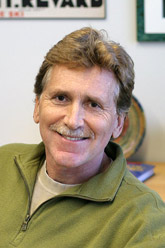From the Director of LCLS:
From Dream to Reality
by Joachim Stöhr
In 1999, a year before I joined SLAC, Keith Hodgson asked me to chair a committee with the charge to develop and document the scientific case for a new revolutionary light source at SLAC, proposed in 1992 by Claudio Pellegrini of UCLA. It had been named
the Linac Coherent Light Source, or LCLS, in the Design Study Report published in 1998. Co-chaired by Gopal Shenoy from Argonne, the committee brainstormed about what to do with pulses of
X-rays that were ultrashort and ultrastrong and had this special property called coherence. Many of us went through a rapid learning curve, exploring what such hot beams would do to a sample, what it meant that the pulses were a thousand times faster than before, and how to take advantage of the coherent nature of the
X-rays.
In essence, the committee was given the opportunity to dream up scientific opportunities afforded by an unprecedented
X-ray laser with a wavelength magically shortened by more than 1000-fold
compared to conventional lasers. The First Experiments document published in September 2000 proposed five experiments which were presented to the Basic Energy Science Advisory Committee of
the Department of Energy on October 10, 2000. I remember worrying whether BESAC would find the
experiments sufficiently exciting to give the green light for LCLS construction.
Read more...
Word of the Week:
Bremsstrahlung Radiation
(Image: Symmetry Breaking.)
by Nicholas Bock
When charged particles are accelerated, they give off energy in the form of electromagnetic radiation. At SLAC, for instance, electrons
speeding around the SPEAR3 ring give off high-energy X-rays that can be harnessed for use in experiments at the Stanford Synchrotron Radiation Light Source.
The term "bremsstrahlung radiation" is a big umbrella, referring to
radiation produced by any kind of acceleration. Etymologically though, bremsstrahlung means
"braking radiation" in German. The term refers to the radiation produced as charged particles slow down. One example of bremsstrahlung
radiation in this sense comes from X-ray tubes, devices where high frequency
radiation is produced by electrons hitting a metal target. X-rays are
generated when electrons in the metal target are ejected by the incoming
electrons and also by incoming electrons' swift deceleration upon collision.
|





 <%
Response.AddHeader "Last-modified", getArticleDate()
'Response.AddHeader "Last-modified","Mon, 01 Sep 1997 01:03:33 GMT"
'Monday, December 06, 2010
%>
<%
Response.AddHeader "Last-modified", getArticleDate()
'Response.AddHeader "Last-modified","Mon, 01 Sep 1997 01:03:33 GMT"
'Monday, December 06, 2010
%>